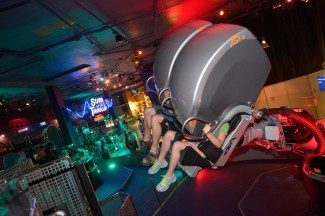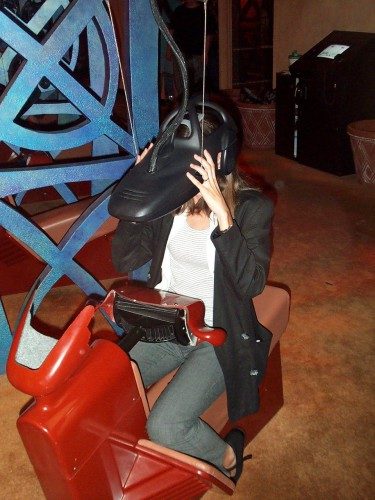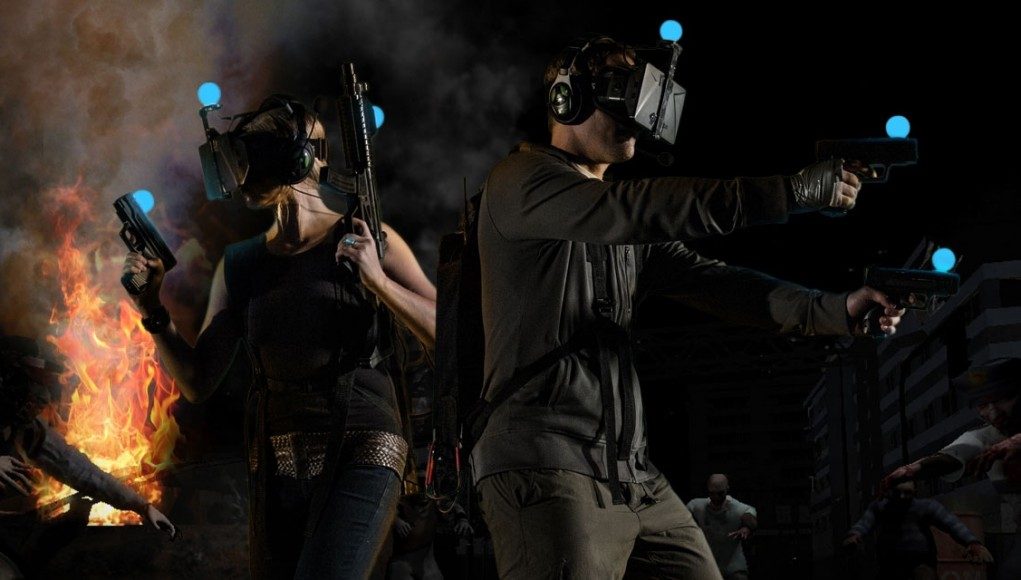
Most notably, and one of the first exhibit applications seen, was from Framestore – a company well known for the special effects creation for such motion film blockbusters as Gravity; Framestore is also known for their marketing and promotional work. The company developed for the travelling HBO exhibit, a celebration of the world of Game of Thrones, a compelling VR experience that saw guests don the Rift DK1 and traverse a recreation of the series’ 700-foot-tall wall environment in an exhibit called Ascend the Wall.
But before this exhibit approach gained public recognition, there had been another VR based immersive promotional exhibit that had gained much interest. Before the Oculus Rift Kickstarter, a UK based company, Inition, developed the Nissan JUKE Wingsuit Experience—working on the brief of ‘Built to Thrill’—an extraordinary marketing experience was created where users used a unique personalized motion-base to steer themselves in a virtual world, linked to a promotional attraction based on the automotive company’s latest work. The unique element of this 2012 experience was that Inition actually hand-crafted their own HMD for the task, with a mixture of off the shelf tech, and 3D printed parts.
An important aspect of the commercial entertainment scene is the use of out-of-home systems in marketing and promotional application. Exhibitions, conventions and special events see HMD’s offering the possibility of a new and interesting promotion platform. A number of the early Rift DK1s found themselves used in such promotions—an example again from Inition in support of London Fashion Week (LFW), with a major retail chain (Top Shop) hiring the company to create a unique experience that placed guests in the window of their flagship store, while viewing the latest fashions from the LFW catwalk, via their virtual reality experience. VR’s commercial entertainment capabilities are finding a willing audience, though hamstrung by a lack of suitable HMD hardware available.
As stated previously; the movie production and marketing companies have latched onto the opportunities of VR as a veritable bandwagon to ride. Previously public entertainment marketing and promotional events such as E3 or Comic-Con would see new movie releases celebrated with elaborate and expensive physical themed exhibits; VR allows marketing and promotional companies to immerse users in CGI scenes from the property in question. Companies such as Legendary Pictures (Pacific Rim: Drift with the Rift), 20th Century Fox (X-Men and Sleepy Hollow VR experiences), and Warner Bros., (Into The Storm: 4D Experience), demonstrated at Comic-Con, and DreamWorks (How to Train Your Dragon 2: Dragon Flight 4D), demonstrated at Time Square; having negotiated unique agreements to be able to use the latest DK2 hardware (before the pubic units were shipped), to promote their respective properties with VR experiences.
Regarding the public-space entertainment sector—once personified by the arcade, and now dominated by the family entertainment center, entertainment restaurant and location-based entertainment venues—there has been a strong interest to re-invest in the original expectations of the early 2000’s to apply VR in the amusement scene, now hoping to be able to achieve this with reliable and cost-effective VR amusement pieces that can be fielded to a brand new generation. Market leading venues Dave & Buster’s and Chuck E. Cheese have both entered into “experiments” for the best approach in VR to suit their unique audiences. Dave & Buster’s expanded into creating a ‘Virtual Reality Lab’ style evaluation environment; while Chuck E. Cheese created a full-blown VR redemption game system (Virtual Ticket Blaster, developed by ReelFX).
The Chuck E. Cheese approach underlined the difficulties of VR in the commercial entertainment market, falling at the first hurdle, having to eventually abandon their plans—embroiled in confusion and contradiction, the company reportedly had to suspended their experiment of using the Rift DK1 development kit with their young audience. While undaunted, other video amusement manufacturers in America and Asia are looking once again at developing VR based amusement pieces—the hope that VR can re-ignite the arcade scene, a dream in many a players’ heart.
Sources close to KWP have revealed that many more amusement and attraction developers have started extensive research into developing what could be called hybrid 4D theaters (physical effect ride film enclosures), using an HMD rather than projecting a 3D film onto a screen. Still in an early stage of development, at recent attraction industry trade events production prototypes using HMDs as a replacement to a projected screen have been presented. Though many fall foul of using consumer HMD systems as a proposed delivery platform, the future is expected to see an explosion of VR-D attractions (as the term for this sector has been coined). From VR-D platforms to VR Visitor Attractions, the need for a commercial entertainment HMD is growing, along with the need for the right unit for the right market.

To be considered also is the full-blown theme park experience—beyond the immersive experience of an audience motion simulator attraction (personified by the likes of Walt Disney’s Star Tours 3D), there has been a drive towards using VR in interactive attractions. One of the longest running VR park attractions are the two experiences within Walt Disney’s DisneyQuest in Orlando, Florida; opened in 1997, the facility has continuously run their Aladdin Magic Carpet flying race and Ride the Comix sword-fighting VR experiences. Often overlooked by those new to the VR scene, these attractions use the specially developed Disney ‘GatorVision’ HMDs. Having paved the way for the best approach for an immersive VR attraction experience, the units are worth much more consideration than they receive.







